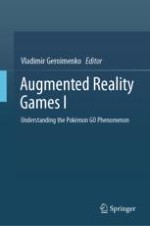2019 | OriginalPaper | Chapter
3. The Concept of the Magic Circle and the Pokémon GO Phenomenon
Authors : Lasse Juel Larsen, Gunver Majgaard
Published in: Augmented Reality Games I
Publisher: Springer International Publishing
Activate our intelligent search to find suitable subject content or patents.
Select sections of text to find matching patents with Artificial Intelligence. powered by
Select sections of text to find additional relevant content using AI-assisted search. powered by
